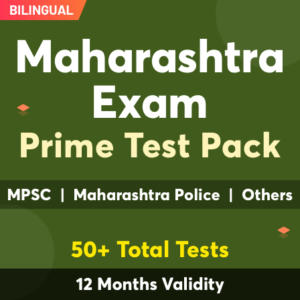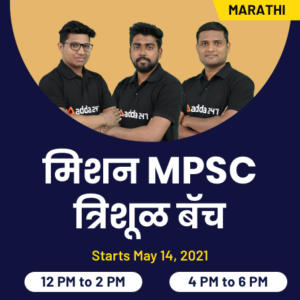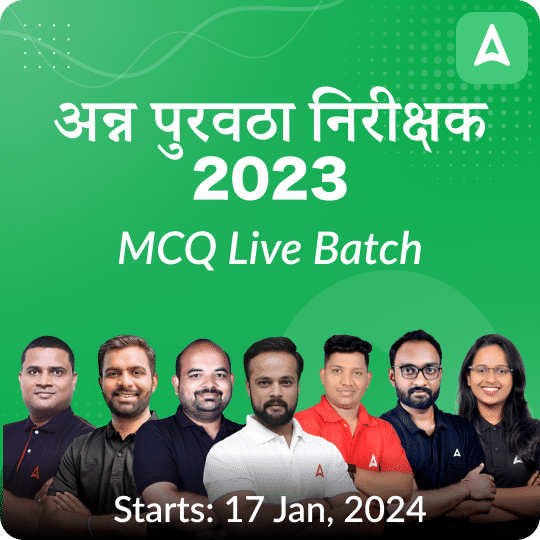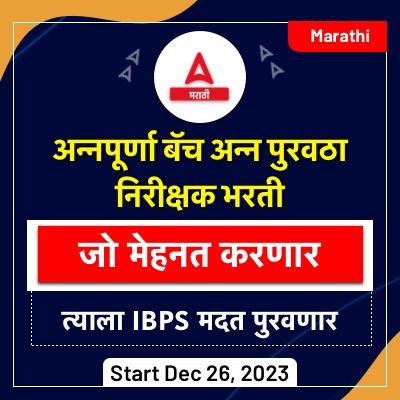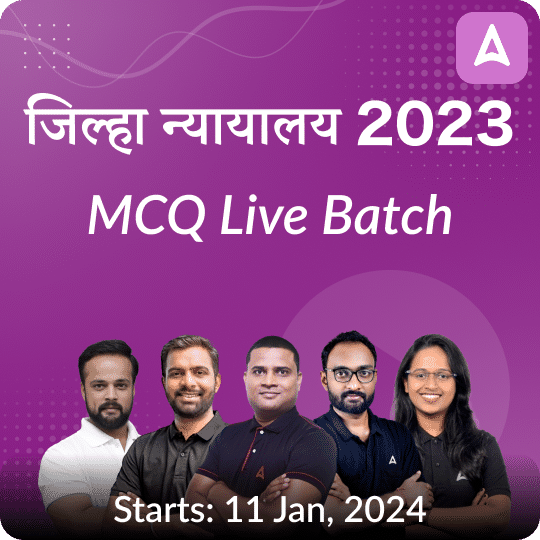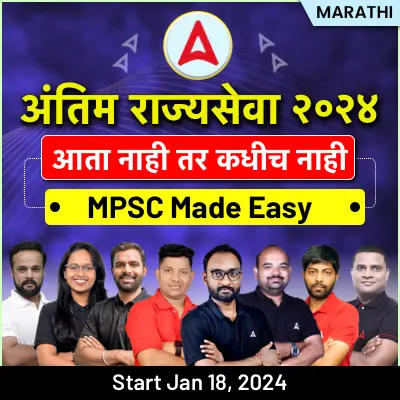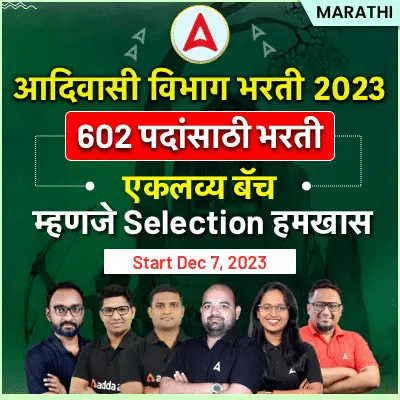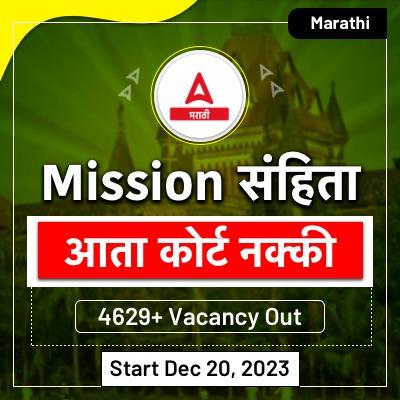Table of Contents
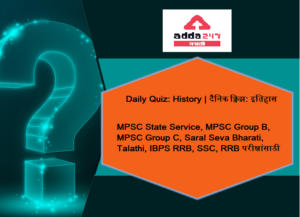
इतिहास दैनिक क्विझ मराठीमध्ये: 10 मे 2021
महाराष्ट्र राज्य लोकसेवा आयोग दरवर्षी वेगवेगळ्या परीक्षे मार्फत हजारो विद्यार्थ्यांची भरती करून घेते MPSC State Service, MPSC Group B, MPSC Group C, Saral Seva Bharati, Talathi, IBPS RRB, SSC, RRB अशा अनेक परीक्षांमार्फत हजारो जागांची भरती दरवर्षी निघते ज्यात लाखो इच्छुक हजार किंवा त्याहूनही कमी जागांसाठी अर्ज करतात. आपण एमपीएससी आणि इतर परीक्षाची तयारी करत असाल तर आपल्याला क्विझ देण्याचे महत्त्व माहित असलेच पाहिजे. बर्याच विद्यार्थ्यांना अभ्यासाचे पुरेसे तास दिले जात असतानाही त्यांना या परीक्षांची पूर्तताही करता आली नाही कारण ते त्यांचे परीक्षण वेळेवर पूर्ण करू शकत नाहीत आणि संशोधन करण्याचा उत्तम मार्ग म्हणजे त्या संबंधित विषयाची किंवा विषयाची क्विझ देणे कारण आपण या मार्गाने कव्हर करू शकता कमी वेळात जास्तीत जास्त विषय. आम्हाला Add 247 मराठी येथे चांगल्या अभ्यास सामग्रीचे मूल्य समजले आहे आणि म्हणूनच आम्ही सर्व विषयांसाठी आपल्याला क्विझ प्रदान करीत आहोत. दैनिक क्विझ देऊन तुम्ही तुमच्या तयारीची पातळी तपासू शकता.
सर्व स्पर्धात्मक विषयांमध्ये इतिहासचाही तेव्हडाच महत्वाचा वाटा आहे. तर चला इतिहास बद्दल तुमची तयारी तपासण्यासाठी खालील 10 मे 2021 ची इतिहासाची दैनिक क्विझ पहा.
Q1. पुढीलपैकी कोणती भारतातील इंग्रजी शिक्षणाची मॅग्ना कार्टा मानली जाते?
(a) वुड्स डेस्पॅच 1854
(b) मॅकॉले मिनिट 1835
(c) हंटर एज्युकेशन कमिशन 1882-83
(d) हार्टोग समिती 1929.
Q2. पुढील विधानांचा विचार करा
- क्रांतिकाऱ्यांचा असा विश्वास होता की ब्रिटनशी राजकीय संबंध ठेवल्यास भारताचे ब्रिटिश शोषण कायम राहील.
- क्रांतिकार्यांनी घटनात्मक सुधारणांची आणि सेवेत असलेल्या भारतीयांना भाग घेण्याची मागणी केली.
- क्रांतिकार्यांनी बहिष्कार आणि निष्क्रिय उद्दीष्टे यासारख्या अतिरिक्त घटनात्मक पद्धतींचा उपयोग करून त्यांचे उद्दीष्ट साध्य केले.
वर दिलेली कोणती विधान /विधाने बरोबर आहे /आहेत?
- 1 आणि 2
- केवळ 2
- 1 आणि 3
- 1, 2 आणि 3
Q3. पुढील विधानांचा विचार करा
- खानवाची लढाई बाबर आणि राणा सांगा यांच्यात झाली.
- बाऊर आणि शेरशाह सूरी यांच्यात चौसाची लढाई झाली.
वर दिलेली कोणती विधान /विधाने बरोबर आहे /आहेत?
(a) केवळ 1
(b) केवळ 2
(c) दोन्ही 1 आणि 2
(d) 1 आणि 2 दोन्ही नाही
Q4. पुढील विधानांचा विचार करा
- 1929 मध्ये लाहोर अधिवेशनात कॉंग्रेसचे उद्दीष्ट्य म्हणून पूर्ण स्वराज घोषित करण्याचा ठराव.
- 1931 मध्ये कराची अधिवेशनात मूलभूत अधिकार आणि राष्ट्रीय आर्थिक कार्यक्रमाचा ठराव मंजूर करण्यात आला.
वर दिलेली कोणती विधान /विधाने बरोबर आहे /आहेत?
(a) केवळ 1
(b) केवळ 2
(c) दोन्ही 1 आणि 2
(d) 1 आणि 2 दोन्ही नाही
Q5. पुढीलपैकी बारडोली सत्याग्रह चा एक महत्त्वपूर्ण पैलू होत?
(a) मोठ्या संख्येने महिलांनी आंदोलनात सक्रिय सहभाग घेतला.
(b) मुस्लिम आणि पारशींनी सामील होण्यापासून परावृत्त केले तर या आंदोलनात हिंदू शेतकऱ्यांचे मोठ्या प्रमाणात वर्चस्व राहिले.
(c) निषेध म्हणून सर्व कॉंग्रेस सदस्यांनी विधानसभेचा राजीनामा दिला.
(d) मिठाच्या सत्याग्रहाचे अग्रदूत म्हणून चळवळीचे नेतृत्व महात्मा गांधी यांनी केले.
Q6. पुढील विधानांचा विचार करा
- सांख्य तत्वज्ञान असे मानते की वास्तविकता दोन तत्त्वांनी बनविली जाते – एक स्त्री आणि दुसरी नर.
- मीमांसा विचारवंतांचा असा विश्वास आहे की विश्वाच्या सर्व वस्तू पृथ्वी, पाणी, वायू, अग्नि आणि ईथर या पाच घटकांनी बनलेल्या आहेत.
वर दिलेली कोणती विधान /विधाने बरोबर आहे /आहेत?
(a) केवळ 1
(b) केवळ 2
(c) दोन्ही 1 आणि 2
(d) 1 आणि 2 दोन्ही नाही
Q7. पिट्स इंडिया अॅक्ट, १848484 खालील बाबींचा विचार करा:
- या अधिनियमान्वये ईस्ट इंडिया कंपनीच्या ताब्यातून संपूर्ण नियंत्रण ब्रिटीश सरकारकडे हस्तांतरित करण्याची तरतूद आहे.
- गव्हर्नर जनरल कौन्सिलची संख्या पाच सदस्यांवर करण्यात आली, त्यातील एक भारतातील किंग्ज आर्मीचा कमांडर-इन-चीफ होता.
वर दिलेली कोणती विधान /विधाने बरोबर आहे /आहेत?
(a) केवळ 1
(b) केवळ 2
(c) दोन्ही 1 आणि 2
(d) 1 आणि 2 दोन्ही नाही
Q8. अल बेरुनीसंदर्भात खालील विधानांचा विचार करा,
- तो मोरोक्कीचा प्रवासी होता.
- भारताबद्दलच्या त्यांच्या प्रवासाच्या नोंदी रिहला या पुस्तकात सापडतात.
- समाजातील चार सामाजिक श्रेणी भारतासाठी विशिष्ट नाहीत असे त्यांनी सुचविले.
वर दिलेली कोणती विधान /विधाने बरोबर आहे /आहेत?
- केवळ 1 आणि 2
- केवळ 3
- 1 आणि 3 only
- 1, 2 आणि 3
Q9. घटनेच्या कच्चा मजकूर समितीचा सदस्य खालीलपैकी कोण नव्हते?
(a) जी.व्ही. मावळणकर
(b) मोहम्मद सादुल्ला
(c) डी.पी. खेतान
(d) बी.एल. मिटर
Q10. 1940 मध्ये ब्रिटीश सरकारने ऑगस्ट ऑफर हा प्रस्ताव ठेवला होता. या संदर्भात पुढीलपैकी कोणते विधान बरोबर नाही?
(a) अल्पसंख्यांकांच्या संमतीशिवाय भविष्यातील कोणतीही घटनेची स्थापना स्वीकारली जाऊ शकत नाही.
(b) मुस्लिम संघाने पाकिस्तानच्या मागणीला कडकपणे मंजुरी दिल्याने ही ऑफर स्वीकारली गेली.
(c) भारतासाठी ब्रिटीश धोरणाचे उद्दीष्ट म्हणून हे वर्चस्व स्थितीसाठी उपलब्ध आहे.
(d) दुसरे महायुद्ध संपल्यानंतर घटना स्थापन करणार्या मंडळाची नेमणूक करण्याचा प्रस्ताव होता
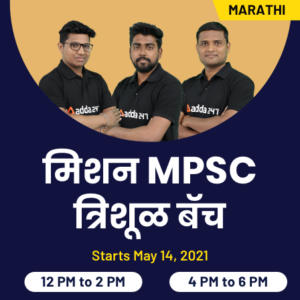
महाराष्ट्र राज्य विविध परीक्षा साहित्य
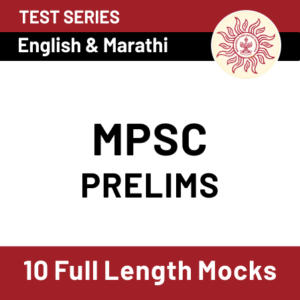
Solutions
S1.Ans.(a)
Sol.
In 1854, Sir Charles Wood, the President of the Board of Control, prepared a despatch on an educational system for India. The despatch came to be considered as the Magna Carta of English education in India. This document was the first comprehensive plan for the spread of English education in India. It proposed setting up Universities in the Presidency towns of Calcutta, Bombay, and Madras.
S2.Ans.(c)
Sol.
The ideology of Extremists:
(1) Rejected England’s providential mission theory as an illusion.
(2) Believed that political connections with Britain would perpetuate British exploitation of India.
(3) Demanded Swaraj as the panacea for Indian ills.
(4) Did not hesitate to use extra-constitutional methods like boycott and passive resistance to achieve their objectives.
S3.Ans.(a)
Sol.
- Babur defeated Mewar’s Rana Sanga in the battle of Khanwa in 1527.
- The Battle of Chausa was fought between Humayun and Sher Shah Suri. Humayun was defeated in this battle in 1539.
S4.Ans.(c)
Sol.
The Karachi Session of Congress is notable for a resolution on Fundamental Rights and the National Economic Program. The resolution guaranteed basic civil and political rights to the people.
- Jawaharlal Nehru was made the President of the Congress at the historic Lahore session of 1929. This event had its romantic side, as the son had succeeded his father (i.e. Motilal Nehru, father of Jawaharlal Nehru was President of the Congress in 1928).
- The Lahore session of the Congress gave voice to the new, militant spirit. It passed a resolution declaring Poorna Swaraj (Full Independence) to be the Congress objective.
S5.Ans.(a)
Sol.
The Bardoli Taluk in modern-day Gujarat was hit by floods and famines in 1925, which adversely affected crop yield. This affected the farmers financially. Ignoring the plight of the farmers, the Bombay Presidency increased the tax rates by 22%. Despite petitions and appeals from civic groups and farmers to review this unjust hike in tax rates in lieu of the grave situation, the government decided to go ahead with tax collection. In 1927, the local Congress Party published a report to show that the farmers could not carry the burden of the enhanced assessment. But the authorities did not budge. In January 1928, farmers in Bardoli invited Vallabhai Patel to launch the protest movement wherein all of them resolved not to pay taxes.
Patel agreed to take on the leadership role only after getting assurances from the farmers of
their resolve to the movement. He informed them of the possible consequences of their move
such as confiscation of land and property and imprisonment.
The Movement:
Patel was an exemplary commander of his non-violent ‘army’ in Bardoli. He divided the taluk into camps and organized hundreds of men and women under the camps. The volunteers came
from Hindu, Muslim, and Parsi communities also. From the camps, volunteers issued news bulletins, campaigns and also made speeches educating the masses about the need to be disciplined and prepared for austerity. Door-to-door campaigning was also done. A large number of women took an active part in the movement. It was these women who gave Patel the moniker ‘Sardar’.
Peasants were asked to take oaths in the name of God that they would not pay the taxes. Those
who paid taxes or were supportive of the British were socially boycotted. They also worked for the betterment of the Kaliparaj caste (farmers who worked as landless laborers). They refused non-essential goods to government offices in the area. They resisted eviction and confiscation (jabti) in unique ways. They had informers in the government offices who would give prior information as to if and when a jabti notice was going to be carried out. The whole village would then move to another place and the officers would be faced with an empty village when they arrived to confiscate the property. KM Munshi and Lalji Naranji resigned from the Bombay Legislative Council. Although the movement was local, it received nation-wide attention and
support
S6.Ans.(a)
Sol.
The Samkhya philosophy holds that reality is constituted of two principles one female and the other male i.e. Prakriti, Purusha respectively. Prakriti and Purusha are completely independent and absolute.
Vaisheshika system is considered as the realistic and objective philosophy of the universe. The reality according to this philosophy has many bases or categories which are substance, attribute, action, genus, distinct quality, and inherence. Vaisheshika thinkers believe that all objects of the universe are composed of five elements.
Mimamsa philosophy is basically the analysis of interpretation, application, and the use of the text of the Samhita and Brahmana portions of the Veda. According to Mimamsa philosophy, Vedas are eternal and possess all knowledge, and religion means the fulfillment of duties prescribed by the Vedas.
S7.Ans.(d)
Sol.
The Pitt’s India Act, 1784 also called the East India Company Act, 1784 was passed by the British
Parliament to correct the defects of the Regulating Act of 1773. This act resulted in dual control of British possessions in India by the British government and the Company with the final authority resting with the government. This act continued in effect till 1858.
- For political matters, the Board of Control was created and for commercial affairs, the Court of Directors was appointed.
- The Board of Control took care of civil and military affairs. It comprised of 6 people:
- Secretary of State (Board President)
- Chancellor of the Exchequer
- Four Privy Councillors
- In this dual system of control, the company was represented by the Court of Directors and the British government by the Board of Control.
- The act mandated that all civil and military officers disclose their property in India and Britain within two months of their joining.
- The Governor-General’s council’s strength was reduced to three members. One of the three would be the Commander-in-Chief of the British Crown’s army in India.
- The Governor-General was given the right of veto.
- The Presidencies of Madras and Bombay became subordinate to the Bengal Presidency. In effect, Calcutta became the capital of the British possessions in India.
S8.Ans.(b)
Sol.
Al-Biruni was a traveler from Uzbekistan who visited in the 11th century in Punjab and the Northern part of India. In his book Kitab-Ul-Hind, he adopted a distinctive structure in his book to describe India. He started each chapter with a question, following up with a description based on Sanskritic traditions, and concluding with a comparison with other cultures. He noted that the four social categories of society were not unique to India, however, criticized the notion of pollution in social strata. Ibn Battuta was a Moroccan traveler who visited India when Muhammad bin Tughlaq was the Sultan of Delhi. He wrote his travelogue known as Rihla.
S9.Ans.(a)
Sol.
On 29th August 1947, the Constituent Assembly through a resolution appointed a Drafting Committee to:
“.. scrutinize the draft of the text of the Constitution of India prepared by Constitutional Adviser, giving effect to the decisions already taken in the Assembly and including all matters which are ancillary thereto or which have to be provided in such a Constitution, and to submit to the Assembly for consideration the text of the draft constitution as revised by the committee”
The Drafting Committee had seven members: Alladi Krishnaswami Ayyar, N. Gopalaswami; B.R.
Ambedkar, K.M. Munshi, Mohammad Saadulla, B.L. Mitter, and D.P. Khaitan. At its first meeting on 30th August 1947, the Drafting Committee
S10.Ans.(b)
Sol.
The august offer was a proposal made by the British government in 1940 promising the expansion of the Executive Council of the Viceroy of India to include more Indians, the establishment of an advisory war council, giving full weight to the minority opinion, and the recognition of Indians’ right to frame their own constitution (after the end of the war). However, this proposal was denied by Congress as the minorities especially the Muslim league was assured that no constitutional scheme was acceptable to the government without their assurance. The Muslim League did not accept the offer as it did not give a clear assurance for the establishment of Pakistan. It offered to set up a Constituent Assembly after the war. Jawahar Lal Nehru said that the whole idea was “dead and doornail”.
महाराष्ट्र राज्य विविध परीक्षा साहित्य
